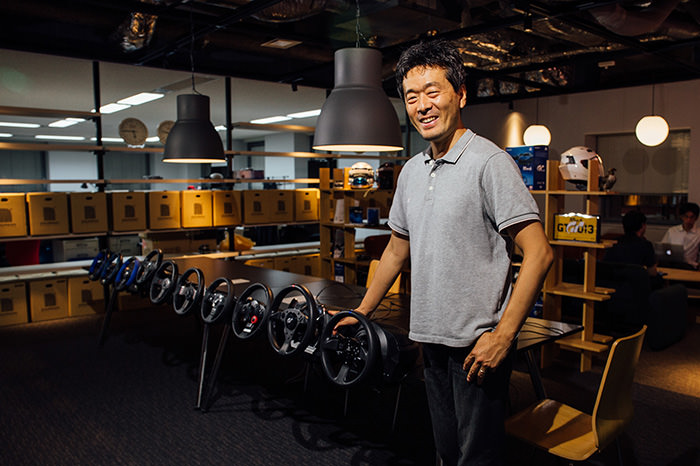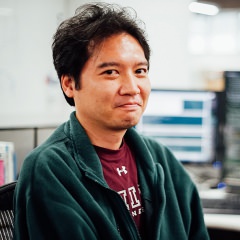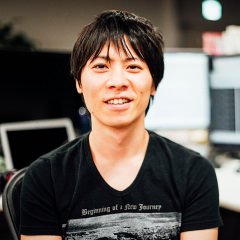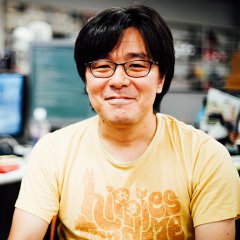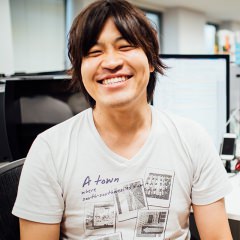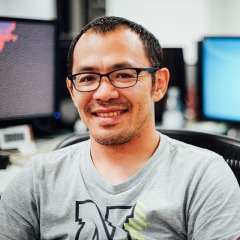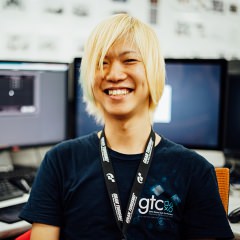WHO WORKS HERE
People Staff Interview
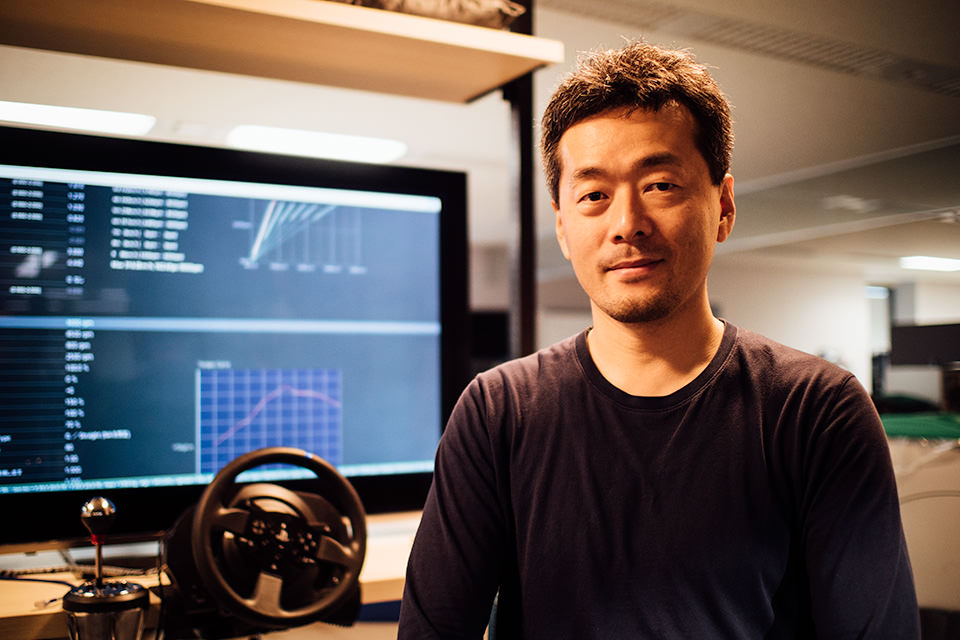
Car Simulation Development Engineer

STAFF INTERVIEW
Joined the predecessor of Polyphony Digital, the "Motor Toon Grand Prix" team of Sony Interactive Entertainment in 1994. Until then he was working in a research lab of a Japanese electronics company. Since then he has been responsible for the vehicle simulation development for the "Motortoon Grand Prix" series, "Gran Turismo" series, and "Tourist Trophy" series.
-
Making 3D mazes with his twin brother
I'm from Fukuoka, and I have a twin brother. I used to love building electronics things since elementary school, and one day in the first year of Jr. High when I went to buy parts at an electronic parts store in town, they had a PC-8001 on display. In electronics, I could recreate circuits introduced in magazines and books by soldering together circuits, but I never reached a level where I could design and come up with circuits myself.
I felt intuitively that I would be able to specify the operations of a computer by combining commands to make it do what I want, and that was more suited for us. So we asked for a computer and our parents bought us the MZ-80K2E, and we coded games in magazines and modified it for fun, and that's how we learned our way around computers. We made 3D mazes ourselves.
-
As a writer in the "Oh! X" magazine
I entered a university in Tokyo, and received an X68000 PC. And in the latter half of my first year in college I got a C language kit, and I wrote piece of ray-tracing software. Then I took the software to the "Oh! X" magazine editor's offices. Looking back that was a pretty bold move.
The software that I brought them wasn't used in an article, but they did give me a job writing articles on a certain theme every month. It involved a large variety of topics, and in addition to physics simulation articles, there were many graphics based themes such as polygon renderers and anti-aliasing.
There was a column that sought to "create a reader programmer" through articles like these demonstrating the development of programs, and I used to introduce "the mode of thinking necessary" to make those programs.
-
Discovery of racing games
In the latter half of my college days, I discovered the 3DCG racing game, "Indianapolis 500: The Simulation", which was a shock. You use the trackball for the steering operation, but even though there's no force feedback like there is in today's steering wheel controllers, it really made you feel like you were driving. Your senses were tricked and it actually felt like you were feeling the understeer in your hands.
The F1 Simulation "World Circuit" and "Hard Drivin'" in the arcade are still my benchmark games. The X68000 back then was good at 2D but in order to do 3D you had to make the CPU draw to the frame buffer through the software.
Stimulated, I wanted to make a similar 3DCG game on the X68000, but eventually I thought it would be too difficult in terms of the hardware's performance, so I gave up.
-
Workstation level 3DCG becoming possible in home game systems
I wanted to work in CG, so I sent my request to the college registrar, and was introduced to a research lab where a former student resided. In the first 2 years, I was in a department doing mathematical calculations, using the finite element method to simulate thermal conductance of materials. Thereafter I was able to move to a CG department, and I was ecstatic to work with a Silicon Graphics workstation for the first time. I was amazed at the fact that you can do environmental mapping and so much more, albeit on a machine costing several hundred thousand dollars.
I continued my column on "Oh! X" even after becoming employed, and I heard through them that "an amazing student has been found!!" ; that was Mr. Yokouchi. He had developed a 3DCG real-time rendering engine on the X68000, something I had given up on. From 1993, he and I wrote a section for the magazine called the "Hardcore 3D Ecstasy", a two part series which consisted of a "Side A" where I would write a vehicle simulation, and a "Side B" where Yokouchi would write about 3DCG.
Mr. Yamauchi, who had read this series article called the editors, and Yokouchi and I spoke to him for the first time in the Editorial office. I remember having the impression of meeting someone incredible, and was drawn into the future that Mr. Yamauchi was envisioning.
Later I went to visit the development office of the “Motor Toon Grand Prix”, and seeing 3DCG running on a home game system, I was enthralled by it and it made me think; “I really want to do something interesting with this!”. Something that I thought only was possible on workstation costing several hundred thousand dollars, was now possible on a home game system. I was only involved in the development from the latter half, but I wrote the physics model of the cars (characters) in “Motor Toon Grand Prix”.
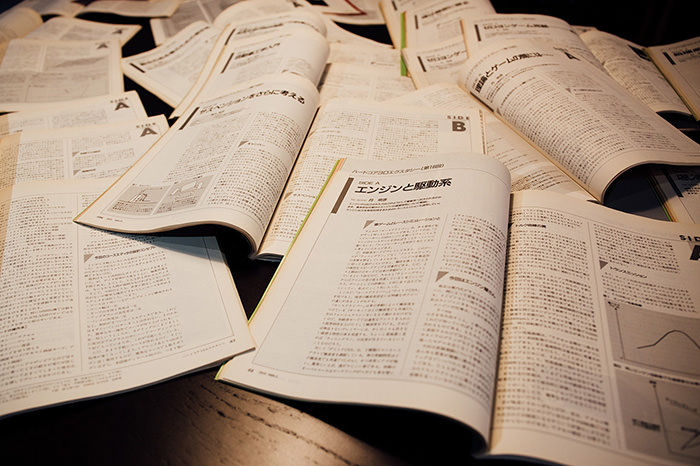
-
The new physics born in "Motor Toon R"
The development of "Motor Toon Grand Prix 2" began immediately. The "Motor Toon Grand Prix" series had a policy set by Yamauchi, that "it would be set in a fantasy world, but would be made as a simulation", and "Motor Toon R", a mode that is unlocked after clearing "Motor Toon Grand Prix 2" achieved this.
The game physics until then, was based on simple actual experience; when you turn the steering wheel, the car turns the way the steering was turned. But in "Motor Toon R", I placed a focus on what sort of physics phenomenon are involved while cornering, and completely redesigned the fundamental part of the algorithm. Whether this would go well or not was a gamble, but as a result, just turning the steering right would not mean you turned right, depending on the condition the car would now drift.
Up until "Motor Toon Grand Prix 2", the car physics would switch to a mode specifically made for drifting to achieve its effect. This was a major breakthrough advancement, opening a path to recreate the unified movement of a car within the same mode.
-
On to "Gran Turismo"
There were many things that came together by accident until this point. For example, the hovercraft character in "Motor Toon Grand Prix 2" was an inspiration. Story wise, the character is a fantasy one, an alien driving a spaceship. But that became the direct ancestor of where we are today.
As the physics engine for "Motor Toon R" took shape, It meant that "Gran Turismo" that was being developed in parallel, could be set forth in this way.
For "Gran Turismo" with its intended 100+ cars and their tuned varieties, it would have been impossible to get all the real cars on the track, and take their driving impressions to implement specific physics for each car.
The mode of thinking from "Motor Toon R" to the latest "Gran Turismo" series, is that the accumulated specs and figures for catalog model cars would recreate the general characteristics of each car.Improvement of minor details and adaption for special cars are done on a case-by case basis, but what is done is basically the same throughout. Ultimately, I'm aiming to create a system that doesn't need specific adjustments for each car, in which you can recreate the car's dynamics just by entering its catalog specs and figures. However of course there are cars like the "Vision Gran Turismo" series, where some of the drive trains use tech that don't even exist today, so we can't rule out individual adjustment altogether.
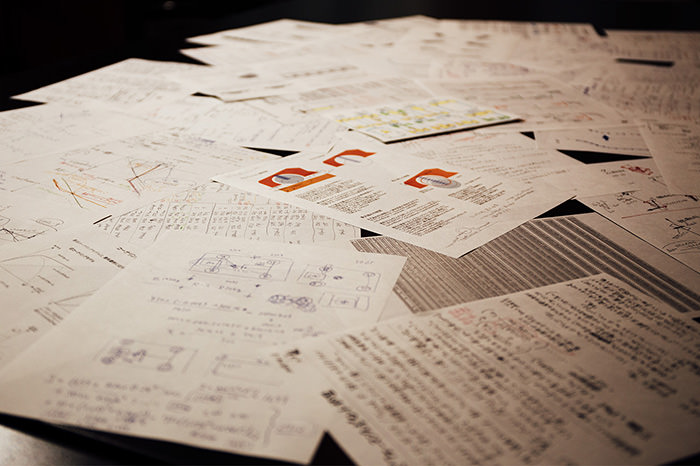
-
The character of Polyphony Digital
There is a policy to strive for ideals. Of course a game is a product, which has sales dates and deadlines, but we try to make the best we can taking as much time as we can for it. And to develop physics engines, requires solid "reasoning".
When you enter data according to the catalog specs, and the car does not move as expected, the easy solution you tend to go for is to add gimmicks based on experience to force it to work, but we try to avoid that as much as possible.
Of course there are exceptions where high cost calculations are made into models, but it still requires the proper reasoning behind them. I think this is something that applies to the entire company, even outside the field of vehicle simulation.
-
Regarding Hiring for a Car Simulation Development Engineer
I would like to see someone join who loves to drive cars, who can understand and seek out the differences between the various cars out there. Of course you need the skill to translate that into a program, but data from manufacturers are not always complete, and requires you to make educated guesses on data that are missing. You also need to communicate with the developers' of manufacturers to make proper adjustments. This is a field that will expand limitlessly the longer you work at it, so it's important that you continue to make an effort to actively research things that you don't know or understand.
Also, there is a game specific device, the steering wheel controller. On a real car, the tires rubber twists and a reaction force is immediately generated, but in a game, there is a delay caused by the communication through the USB and the simulation frequency, which deteriorates the steering feel. This field is still in early stages of development, so I would like to find comrades who will research this with us, and help build the future of "Gran Turismo" together.
